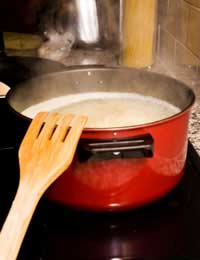How to Cook Pasta

This will probably be one of the first meals you'll learn to cook if you're a novice in the kitchen: it's very easy, very quick and can be tasty and filling - perfect student food. However, despite being a very simple dish, there are literally hundreds of different ways of cooking and combining pasta and sauces, which is why you see it on every menu, from your local pub to the best restaurant in town. It's also very easy to get it wrong and pasta that is just a little over or undercooked will not make for a pleasant meal.
The Knowledge
Although Italy is renowned as being the birthplace of pasta, there are mentions of it in ancient Greek and Arabic texts and various forms of pasta were undoubtedly used in cuisines all around the world. However, it was the Italians who truly adopted pasta and developed the possibilities of this wonderfully versatile food.Most dried pasta is made from just flour, water and salt. Fresh pasta will often contain eggs as well, as it's designed to be consumed sooner. Pasta comes in all different shapes and sizes, as well as stuffed pastas (such as ravioli and tortellini), and flat sheets that are used to make lasagne. Here are some of the more well-known varieties:
Penne
These are small, ridged tubes cut on the diagonal. The ridges help to hold the sauce and penne works well with chunky tomato-based sauces.Macaroni
Forget the macaroni cheese you used to get served for your school lunch; if this is made well, it's absolutely delicious.Farfalle
You might know these better as 'bows'. They are great with tomato sauces or in a pasta salad.Spaghetti
These long, thin strands are probably most widely eaten as spaghetti Bolognese. However, they also work well with really simple sauces such as olive oil, garlic and herbs.Tagliatelle
A kind of squashed, wider version of spaghetti, tagliatelle is often combined with a creamy sauce, such as carbonara.Cooking Dried Pasta
It's really all to do with timings and tasting when it comes to cooking pasta. Different varieties take a longer or shorter time to cook, so always check the instructions on the packet. However, you shouldn't just rely on this and it's advisable to try a piece before deciding if it's time to dish up.- Pour boiling water from the kettle into a large pan and place over a high heat to bring it back to the boil. Add a pinch of salt.
- Most pasta swells significantly while cooking and you may end up with far too much.
- Add the pasta to the boiling water and let it cook, according to the packet instructions. Try a piece to check you're happy that it's cooked and, if not, leave it a little longer. You want your pasta to retain its shape and have a little bite to it (al dente).
- Drain it well and return to the hot pan (off the heat) and stir in your sauce. It's important to do this and mix well before serving, as pasta will stick together once it's drained.
Cooking Fresh Pasta
Fresh pasta cooks a lot more quickly than dried and it's also more delicate so try and avoid stirring it while it's cooking. It will usually take no more than a few minutes to cook so you really need to keep an eye on the time as, if it's overcooked, it will become very soggy and lose its shape. As with dried pasta, cook in a large pan of boiling, salted water and drain very thoroughly once it's cooked. Again, you should add the sauce immediately and mix well, but carefully, before serving.It takes a little practise but pasta really is quick and easy to prepare. Try some of the more unusual varieties for a change and have a go at making your own sauces.


Re: Working Out a Food Budget
Great advice! Setting a food budget is all about balance, and these tips really help to keep things manageable without compromising on…
Re: How to Make Basic Sauces
nice, but i think it would be better if you had, like, satay sauce, and garlic dip. but still, nice.
Re: Organising Your Kitchen
how do l cook jollof rice and frid rice..also vegetable soup..
Re: Dinner in 10 Minutes
What else can you do with jacket potato I have butter and a bit of gravy with mine
Re: The Quick Guide to Great Cooking
i'm a student want to learn more basic sauce and any additional ingredients for cream sauce white sauce.thank you
Re: Ten Ideas for Jacket Potatoes
Please could you add pictures of the goods if possible.
Re: How to Cook Fish
Your advice on poaching (and other ways of cooking) haddock seems very sensible and in touch with real life. This ( I know comparisons are odious…
Re: Ten Ideas for Jacket Potatoes
Could you help me with easy toppings for jaket bbq bake potatos ,for to cook 30 at a time need some help ,so come all you great…
Re: Meals for £1
Bb - Your Question:Students don't have luxrys like oil and an onion just hanging about or pepperOur Re
Re: Cooking in Bulk
Go into supermarkets late in the day and pick up reduced veg, Take home cut up in dinner portion Bags up in freezer bags Put in freezer til you…